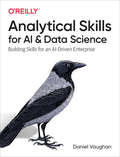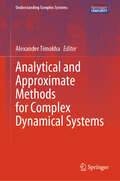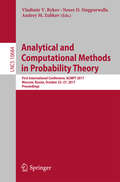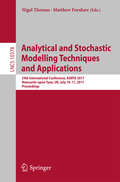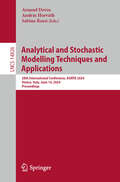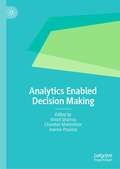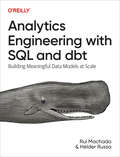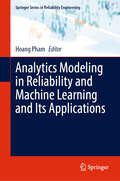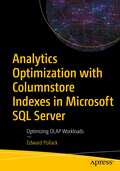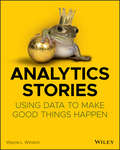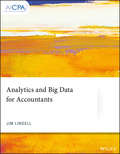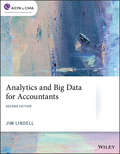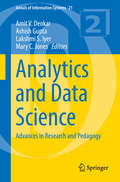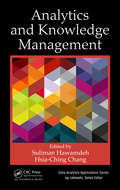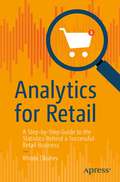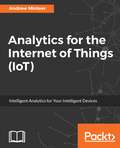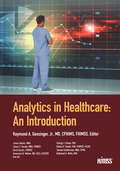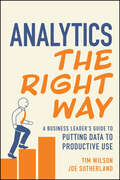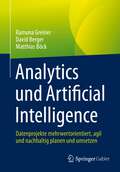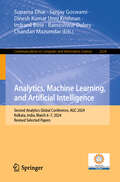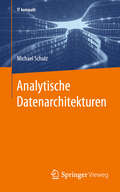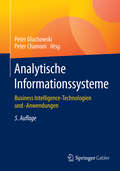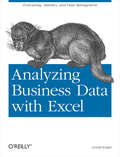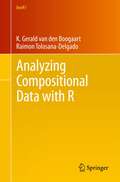- Table View
- List View
Analytical Skills for AI and Data Science: Building Skills for an AI-Driven Enterprise
by Daniel VaughanWhile several market-leading companies have successfully transformed their business models by following data- and AI-driven paths, the vast majority have yet to reap the benefits. How can your business and analytics units gain a competitive advantage by capturing the full potential of this predictive revolution? This practical guide presents a battle-tested end-to-end method to help you translate business decisions into tractable prescriptive solutions using data and AI as fundamental inputs.Author Daniel Vaughan shows data scientists, analytics practitioners, and others interested in using AI to transform their businesses not only how to ask the right questions but also how to generate value using modern AI technologies and decision-making principles. You’ll explore several use cases common to many enterprises, complete with examples you can apply when working to solve your own issues.Break business decisions into stages that can be tackled using different skills from the analytical toolboxIdentify and embrace uncertainty in decision making and protect against common human biasesCustomize optimal decisions to different customers using predictive and prescriptive methods and technologiesAsk business questions that create high value through AI- and data-driven technologies
Analytical and Approximate Methods for Complex Dynamical Systems (Understanding Complex Systems)
by Alexander TimokhaThis book presents Analytical and Approximate Methods for Complex Dynamical Systems and introduces ideas of discontinuous mapping treated as complex dynamical systems. Mathematicians of world-recognized Ukrainian scientific schools established by M.Krylov, M.Bogolyubov, Yu.Mitropolskiy, and A.Sharkovsky used to cooperate for writing the collective book whose purpose consists of illustrating a synergy of combining diverse (by idea and technique) constructive analytical and approximate approaches and methods in complex dynamical systems which are herein associated with mathematical models of networks, conflict/economic theories, sloshing, soft matter, and even levitating drops. Readers are facilitated to learn contemporary insights, fundamentals (Parts I and III), applications (Part II), and components of theories of bifurcation, synchronization/self-organization, collective dynamics, chaos, solitons, fractional differential equations, symmetry, reduced order modelling, and many others, that makes the book useful for both graduate and postgraduate students, lecturers, researchers, and even engineers dealing with multidimensional dynamic systems.
Analytical and Computational Methods in Probability Theory: First International Conference, ACMPT 2017, Moscow, Russia, October 23-27, 2017, Proceedings (Lecture Notes in Computer Science #10684)
by Vladimir V. Rykov Nozer D. Singpurwalla Andrey M. ZubkovThis book constitutes the refereed proceedings of the First International Conference on Analytical and Computational Methods in Probability Theory and its Applications, ACMPT 2017, held in Moscow, Russia, in October 2017. The 42 full papers presented were carefully reviewed and selected from 173 submissions. The conference program consisted of four main themes associated with significant contributions made by A. D. Soloviev. These are: Analytical methods in probability theory, Computational methods in probability theory, Asymptotical methods in probability theory, the history of mathematics.
Analytical and Stochastic Modelling Techniques and Applications: 24th International Conference, ASMTA 2017, Newcastle-upon-Tyne, UK, July 10-11, 2017, Proceedings (Lecture Notes in Computer Science #10378)
by Nigel Thomas Matthew ForshawThis book constitutes the refereed proceedings of the 24th International Conference on Analytical and Stochastic Modelling Techniques and Applications, ASMTA 2017, held in Newcastle-upon-Tyne UK, in July 2017.The 14 full papers presented in this book were carefully reviewed and selected from 27 submissions. The scope of the conference is on following topics: analytical, numerical and simulation algorithms for stochastic systems, including Markov processes, queueing networks, stochastic Petri nets, process algebras, game theoretical models.
Analytical and Stochastic Modelling Techniques and Applications: 25th International Conference, ASMTA 2019, Moscow, Russia, October 21–25, 2019, Proceedings (Lecture Notes in Computer Science #12023)
by Marco Gribaudo Eduard Sopin Irina KochetkovaThis book constitutes the refereed proceedings of the 25th International Conference on Analytical and Stochastic Modelling Techniques and Applications, ASMTA 2019, held in Moscow, Russia, in October 2019. Methods of analytical and stochastic modelling are widely used in engineering to assess and design various complex systems, like computer and communication networks, and manufacturing systems. The 13 full papers presented in this book were carefully reviewed and selected from 22 submissions. The papers detail a diverse range of analysis techniques, including Markov processes, queueing theoretical results, reliability of stochastic systems, stochastic network calculus, and wide variety of applications.
Analytical and Stochastic Modelling Techniques and Applications: 28th International Conference, ASMTA 2024, Venice, Italy, June 14, 2024, Proceedings (Lecture Notes in Computer Science #14826)
by András Horváth Arnaud Devos Sabina RossiThis book constitutes the refereed proceedings of the 28th International Conference on Analytical and Stochastic Modelling Techniques and Applications, ASMTA 2024, held in Venice, Italy, on June 14, 2024. The 10 full papers presented were carefully reviewed and selected from 14 submissions. These papers covered a wide range of topics in analytical and stochastic modeling techniques and their applications.
Analytics Enabled Decision Making
by Vinod Sharma Chandan Maheshkar Jeanne PouloseAnalytics is changing the landscape of businesses across sectors globally. This has led to the stimulation of interest of scholars and practitioners worldwide in this domain. The emergence of ‘big data’, has fanned the usages of machine learning techniques and the acceptance of ‘Analytics Enabled Decision Making’. This book provides a holistic theoretical perspective combined with the application of such theories by drawing on the experiences of industry professionals and academicians from around the world. The book discusses several paradigms including pattern mining, clustering, classification, and data analysis to name a few. The main objective of this book is to offer insight into the process of decision-making that is accelerated and made more precise with the help of analytics.
Analytics Engineering with SQL and dbt: Building Meaningful Data Models at Scale
by Rui Pedro Machado Helder RussaWith the shift from data warehouses to data lakes, data now lands in repositories before it's been transformed, enabling engineers to model raw data into clean, well-defined datasets. dbt (data build tool) helps you take data further. This practical book shows data analysts, data engineers, BI developers, and data scientists how to create a true self-service transformation platform through the use of dynamic SQL.Authors Rui Machado from Monstarlab and Hélder Russa from Jumia show you how to quickly deliver new data products by focusing more on value delivery and less on architectural and engineering aspects. If you know your business well and have the technical skills to model raw data into clean, well-defined datasets, you'll learn how to design and deliver data models without any technical influence.With this book, you'll learn:What dbt is and how a dbt project is structuredHow dbt fits into the data engineering and analytics worldsHow to collaborate on building data modelsThe main tools and architectures for building useful, functional data modelsHow to fit dbt into data warehousing and laking architectureHow to build tests for data transformations
Analytics Modeling in Reliability and Machine Learning and Its Applications (Springer Series in Reliability Engineering)
by Hoang PhamThis book presents novel research and application chapters on topics in reliability, statistics, and machine learning. It has an emphasis on analytical models and techniques and practical applications in reliability engineering, data science, manufacturing, health care, and industry using machine learning, AI, optimization, and other computational methods. Today, billions of people are connected to each other through their mobile devices. Data is being collected and analysed more than ever before. The era of big data through machine learning algorithms, statistical inference, and reliability computing in almost all applications has resulted in a dramatic shift in the past two decades. Data analytics in business, finance, and industry is vital. It helps organizations and business to achieve better results and fact-based decision-making in all aspects of life. The book offers a broad picture of current research on the analytics modeling and techniques and its applications in industry. Topics include: l Reliability modeling and methods. l Software reliability engineering. l Maintenance modeling and policies. l Statistical feature selection. l Big data modeling. l Machine learning: models and algorithms. l Data-driven models and decision-making methods. l Applications and case studies in business, health care, and industrial systems. Postgraduates, researchers, professors, scientists, engineers, and practitioners in reliability engineering and management, machine learning engineering, data science, operations research, industrial and systems engineering, statistics, computer science and engineering, mechanical engineering, and business analytics will find in this book state-of-the-art analytics, modeling and methods in reliability and machine learning.
Analytics Optimization with Columnstore Indexes in Microsoft SQL Server: Optimizing OLAP Workloads
by Edward PollackMeet the challenge of storing and accessing analytic data in SQL Server in a fast and performant manner. This book illustrates how columnstore indexes can provide an ideal solution for storing analytic data that leads to faster performing analytic queries and the ability to ask and answer business intelligence questions with alacrity. The book provides a complete walk through of columnstore indexing that encompasses an introduction, best practices, hands-on demonstrations, explanations of common mistakes, and presents a detailed architecture that is suitable for professionals of all skill levels. With little or no knowledge of columnstore indexing you can become proficient with columnstore indexes as used in SQL Server, and apply that knowledge in development, test, and production environments. This book serves as a comprehensive guide to the use of columnstore indexes and provides definitive guidelines. You will learn when columnstore indexes should be used, and the performance gains that you can expect. You will also become familiar with best practices around architecture, implementation, and maintenance. Finally, you will know the limitations and common pitfalls to be aware of and avoid.As analytic data can become quite large, the expense to manage it or migrate it can be high. This book shows that columnstore indexing represents an effective storage solution that saves time, money, and improves performance for any applications that use it. You will see that columnstore indexes are an effective performance solution that is included in all versions of SQL Server, with no additional costs or licensing required. What You Will LearnImplement columnstore indexes in SQL ServerKnow best practices for the use and maintenance of analytic data in SQL ServerUse metadata to fully understand the size and shape of data stored in columnstore indexesEmploy optimal ways to load, maintain, and delete data from large analytic tablesKnow how columnstore compression saves storage, memory, and timeUnderstand when a columnstore index should be used instead of a rowstore indexBe familiar with advanced features and analyticsWho This Book Is ForDatabase developers, administrators, and architects who are responsible for analytic data, especially for those working with very large data sets who are looking for new ways to achieve high performance in their queries, and those with immediate or future challenges to analytic data and query performance who want a methodical and effective solution
Analytics Stories: Using Data to Make Good Things Happen
by Wayne L. WinstonInform your own analyses by seeing how one of the best data analysts in the world approaches analytics problems Analytics Stories: How to Make Good Things Happen is a thoughtful, incisive, and entertaining exploration of the application of analytics to real-world problems and situations. Covering fields as diverse as sports, finance, politics, healthcare, and business, Analytics Stories bridges the gap between the oft inscrutable world of data analytics and the concrete problems it solves. Distinguished professor and author Wayne L. Winston answers questions like: Was Liverpool over Barcelona the greatest upset in sports history? Was Derek Jeter a great infielder What's wrong with the NFL QB rating? How did Madoff keep his fund going? Does a mutual fund’s past performance predict future performance? What caused the Crash of 2008? Can we predict where crimes are likely to occur? Is the lot of the American worker improving? How can analytics save the US Republic? The birth of evidence-based medicine: How did James Lind know citrus fruits cured scurvy? How can I objectively compare hospitals? How can we predict heart attacks in real time? How does a retail store know if you're pregnant? How can I use A/B testing to improve sales from my website? How can analytics help me write a hit song? Perfect for anyone with the word “analyst” in their job title, Analytics Stories illuminates the process of applying analytic principles to practical problems and highlights the potential pitfalls that await careless analysts.
Analytics and Big Data for Accountants (AICPA)
by Jim LindellAnalytics is a new force driving business. Tools have been created to measure program effects and return on investment, visualize data and business processes, and uncover the relationship between key performance indicators—many using the unprecedented amount of data now moving into organizations. In this course, you will discuss leading-edge topics in analytics and finance in a session that is packed with useful tips and practical guidance that you can apply immediately.
Analytics and Big Data for Accountants (AICPA)
by Jim LindellWhy is big data analytics one of the hottest business topics today? This book will help accountants and financial managers better understand big data and analytics, including its history and current trends. It dives into the platforms and operating tools that will help you measure program impacts and ROI, visualize data and business processes, and uncover the relationship between key performance indicators. Key topics covered include: Evidence-based techniques for finding or generating data, selecting key performance indicators, isolating program effects Relating data to return on investment, financial values, and executive decision making Data sources including surveys, interviews, customer satisfaction, engagement, and operational data Visualizing and presenting complex results
Analytics and Data Science: Advances in Research and Pedagogy (Annals of Information Systems #21)
by Ashish Gupta Lakshmi S. Iyer Amit V. Deokar Mary C. JonesThis book explores emerging research and pedagogy in analytics and data science that have become core to many businesses as they work to derive value from data. The chapters examine the role of analytics and data science to create, spread, develop and utilize analytics applications for practice. Selected chapters provide a good balance between discussing research advances and pedagogical tools in key topic areas in analytics and data science in a systematic manner. This book also focuses on several business applications of these emerging technologies in decision making, i. e. , business analytics. The chapters in Analytics and Data Science: Advances in Research and Pedagogy are written by leading academics and practitioners that participated at the Business Analytics Congress 2015. Applications of analytics and data science technologies in various domains are still evolving. For instance, the explosive growth in big data and social media analytics requires examination of the impact of these technologies and applications on business and society. As organizations in various sectors formulate their IT strategies and investments, it is imperative to understand how various analytics and data science approaches contribute to the improvements in organizational information processing and decision making. Recent advances in computational capacities coupled by improvements in areas such as data warehousing, big data, analytics, semantics, predictive and descriptive analytics, visualization, and real-time analytics have particularly strong implications on the growth of analytics and data science.
Analytics and Knowledge Management (Data Analytics Applications)
by Suliman Hawamdeh and Hsia-Ching ChangThe process of transforming data into actionable knowledge is a complex process that requires the use of powerful machines and advanced analytics technique. Analytics and Knowledge Management examines the role of analytics in knowledge management and the integration of big data theories, methods, and techniques into an organizational knowledge management framework. Its chapters written by researchers and professionals provide insight into theories, models, techniques, and applications with case studies examining the use of analytics in organizations. The process of transforming data into actionable knowledge is a complex process that requires the use of powerful machines and advanced analytics techniques. Analytics, on the other hand, is the examination, interpretation, and discovery of meaningful patterns, trends, and knowledge from data and textual information. It provides the basis for knowledge discovery and completes the cycle in which knowledge management and knowledge utilization happen. Organizations should develop knowledge focuses on data quality, application domain, selecting analytics techniques, and on how to take actions based on patterns and insights derived from analytics. Case studies in the book explore how to perform analytics on social networking and user-based data to develop knowledge. One case explores analyze data from Twitter feeds. Another examines the analysis of data obtained through user feedback. One chapter introduces the definitions and processes of social media analytics from different perspectives as well as focuses on techniques and tools used for social media analytics. Data visualization has a critical role in the advancement of modern data analytics, particularly in the field of business intelligence and analytics. It can guide managers in understanding market trends and customer purchasing patterns over time. The book illustrates various data visualization tools that can support answering different types of business questions to improve profits and customer relationships. This insightful reference concludes with a chapter on the critical issue of cybersecurity. It examines the process of collecting and organizing data as well as reviewing various tools for text analysis and data analytics and discusses dealing with collections of large datasets and a great deal of diverse data types from legacy system to social networks platforms.
Analytics for Retail: A Step-by-Step Guide to the Statistics Behind a Successful Retail Business
by Rhoda OkunevExamine select retail business scenarios to learn basic mathematics, as well as probability and statistics required to analyze big data. This book focuses on useful and imperative applied analytics needed to build a retail business and explains mathematical concepts essential for decision making and communication in retail business environments. Everyone is a buyer or seller of products these days whether through a physical department store, Amazon, or their own business website. This book is a step-by-step guide to understanding and managing the mechanics of markups, markdowns, and basic statistics, math and computers that will help in your retail business. You'll tackle what to do with data once it is has accumulated and see how to arrange the data using descriptive statistics, primarily means, median, and mode, and then how to read the corresponding charts and graphs. Analytics for Retail is your path to creating visual representations that powerfully communicate information and drive decisions. What You'll LearnReview standard statistical concepts to enhance your understanding of retail dataUnderstand the concepts of markups, markdowns and profit margins, and probability Conduct an A/B testing email campaign with all the relevant analytics calculated and explainedWho This Book Is ForThis is a primer book for anyone in the field of retail that needs to learn or refresh their skills or for a reader who wants to move in their company to a more analytical position.
Analytics for the Internet of Things (IoT)
by Andrew MinteerThis book targets developers, IoT professionals, and those in the field of data science who are trying to solve business problems through IoT devices and would like to analyze IoT data. IoT enthusiasts, managers, and entrepreneurs who would like to make the most of IoT will find this equally useful. A prior knowledge of IoT would be helpful but is not necessary. Some prior programming experience would be useful
Analytics in Healthcare: An Introduction (HIMSS Book Series)
by Raymond A. GensingerThe editors of the HIMSS Books' best-seller Health: From Smartphones to Smart Systems have returned to deliver an expansive survey of the initiatives, innovators, and technologies driving the patient-centered mobile healthcare revolution. mHealth Innovation: Best Practices from the Mobile Frontier explores the promise of mHealth as a balance between emerging technologies and process innovations leading to improved outcomes-with the ultimate aim of creating a patient-centered and consumer-driven healthcare ecosystem. Examining the rapidly changing mobile healthcare environment from myriad perspectives, the book includes a comprehensive survey of the current-state ecosystem-app development, interoperability, security, standards, organizational and governmental policy, innovation, next-generation solutions, and mBusiness-and 20 results-driven, world-spanning case studies covering behavior change, patient engagement, patient-provider decision making, mobile gaming, mobile prescription therapy, home monitoring, mobile-to-mobile online delivery, access to care, app certification and quality evaluations, mixed media campaigns, and much more.
Analytics the Right Way: A Business Leader's Guide to Putting Data to Productive Use
by Tim Wilson Joe SutherlandCLEAR AND CONCISE TECHNIQUES FOR USING ANALYTICS TO DELIVER BUSINESS IMPACT AT ANY ORGANIZATION Organizations have more data at their fingertips than ever, and their ability to put that data to productive use should be a key source of sustainable competitive advantage. Yet, business leaders looking to tap into a steady and manageable stream of “actionable insights” often, instead, get blasted with a deluge of dashboards, chart-filled slide decks, and opaque machine learning jargon that leaves them asking, “So what?” Analytics the Right Way is a guide for these leaders. It provides a clear and practical approach to putting analytics to productive use with a three-part framework that brings together the realities of the modern business environment with the deep truths underpinning statistics, computer science, machine learning, and artificial intelligence. The result: a pragmatic and actionable guide for delivering clarity, order, and business impact to an organization’s use of data and analytics. The book uses a combination of real-world examples from the authors’ direct experiences—working inside organizations, as external consultants, and as educators—mixed with vivid hypotheticals and illustrations—little green aliens, petty criminals with an affinity for ice cream, skydiving without parachutes, and more—to empower the reader to put foundational analytical and statistical concepts to effective use in a business context.
Analytics und Artificial Intelligence: Datenprojekte mehrwertorientiert, agil und nachhaltig planen und umsetzen
by Matthias Böck David Berger Ramona GreinerDie Autoren zeigen in diesem Buch, wie man für eigene Data-Science-Projekte mit Data Analytics und AI einen echten (Mehr-)Wert schafft. Sie entwickeln einen Leitfaden, mit dem Sie Ihre Datenanalyse systematisch, agil und nutzer:innenzentriert aufbauen und betreiben können. Zunächst machen die Autoren klar, wie wichtig es ist zu Beginn Ihrer Analytics-Projekte die für Ihr Geschäftsmodell richtigen und wertstiftenden Fragen zu stellen. Im Anschluss erläutern sie, wie Sie Technologien und Daten so einsetzen, dass sie einen echten Mehrwert erzeugen können. Schließlich zeigen sie, wie Sie die Projekte effektiv, effizient und gewinnbringend umsetzen können. Das Fundament dafür bilden agile Methoden und Design Thinking, die die Autoren für alltägliche Analytics- und Data-Science-Projekte überführt und adaptiert haben.Mit zahlreichen Beispielen und Erfahrungen aus Daten-, Web- und Digital-Analytics-Projekten sowie zwei realen Beispielen, wie man von der Idee und dem Auftrag zum Prototypen kommt. Aus dem Inhalt Agile Basics: Agile Prinzipien und ErfolgsfaktorenVom Design Thinking zum Data Thinking – wie Design Thinking Datenprojekte besser machtArtificial Intelligence – wie Künstliche Intelligenz mehrwertorientiert in Data Analytics eingesetzt werden kannEthische, rechtliche und ökologische Implikationen – wie Data Analytics und AI doch kein Schreckgespenst werdenDer Data Value Loop - Datenmehrwert agil und nutzer:innenzentriertAnalytics in der Praxis – von der Konzeption über Tracking und Reporting bis zum Arbeitsmeeting im AlltagAI in der Praxis - Data Science und Agile, geht das überhaupt zusammen? Zwei exemplarische ProjektdurchführungenGlossar
Analytics, Machine Learning, and Artificial Intelligence: Second Analytics Global Conference, AGC 2024, Kolkata, India, March 6–7, 2024, Revised Selected Papers (Communications in Computer and Information Science #2224)
by Chandan Mazumdar Suparna Dhar Sanjay Goswami Indranil Bose Rameshwar Dubey Dinesh Kumar Unni KrishnanThis book constitutes the refereed proceedings of the Second Analytics Global Conference on Analytics, Machine Learning, and Artificial Intelligence, AGC 2024, held in Kolkata, India, during March 6-7, 2024. The 15 full papers and 3 short papers presented in these proceedings were carefully reviewed and selected from 60 submissions. The papers are organized in these topical sections: applications of analytics in business; analytics methods, tools & techniques.
Analytische Datenarchitekturen (IT kompakt)
by Michael SchulzLange Zeit waren Data Warehouse, Data Mart und Operational Data Store die einzigen verbreiteten Komponenten einer analytischen Datenarchitektur. Die zunehmende Verwendung komplexer Daten zur Entscheidungsunterstützung hat in den letzten Jahren Architekturkomponenten wie den Data Lake oder Möglichkeiten zur analytischen Verwendung von Stromdaten hervorgebracht. War ihr Einsatz in vielen Organisationen zunächst von Misserfolgen begleitet, haben sich mittlerweile Grundsätze etabliert, die einen sinnvollen Einsatz ermöglichen. Seit kurzem sind mit Data Lakehouse, Data Fabric und Data Mesh weitere Ansätze in der Diskussion. Durch diese Vielzahl existierender Ansätze ist der Themenkomplex unübersichtlich geworden und es wird immer schwieriger, den Überblick zu behalten. Genau darin liegt die Zielsetzung des vorliegenden Buches: Mit einem klaren Fokus auf derzeit relevante Architekturkomponenten sollen ihre Hauptmerkmale verdeutlicht werden.
Analytische Informationssysteme: Business Intelligence-Technologien und -Anwendungen
by Peter Gluchowski Peter ChamoniInformationssysteme für die analytischen Aufgaben von Fach- und Führungskräften treten verstärkt in den Vordergrund. Dieses etablierte Buch diskutiert und evaluiert Begriffe und Konzepte wie Business Intelligence und Big Data. Die aktualisierte und erweiterte fünfte Auflage liefert einen aktuellen Überblick zu Technologien, Produkten und Trends im Bereich analytischer Informationssysteme. Beiträge aus Wirtschaft und Wissenschaft geben einen umfassenden Überblick und eignen sich als fundierte Entscheidungsgrundlage beim Aufbau und Einsatz derartiger Technologien.
Analyzing Business Data with Excel: Forecasting, Statistics, and Data Management
by Gerald KnightAs one of the most widely used desktop applications ever created, Excel is familiar to just about everyone with a computer and a keyboard. Yet most of us don't know the full extent of what Excel can do, mostly because of its recent growth in power, versatility, and complexity. The truth is that there are many ways Excel can help make your job easier-beyond calculating sums and averages in a standard spreadsheet.Analyzing Business Data with Excel shows you how to solve real-world business problems by taking Excel's data analysis features to the max. Rather than focusing on individual Excel functions and features, the book keys directly on the needs of business users. Most of the chapters start with a business problem or question, and then show you how to create pointed spreadsheets that address common data analysis issues.Aimed primarily at experienced Excel users, the book doesn't spend much time on the basics. After introducing some necessary general tools, it quickly moves into more specific problem areas, such as the following:StatisticsPivot tablesWorkload forecastingModelingMeasuring qualityMonitoring complex systemsQueuingOptimizingImporting dataIf you feel as though you're getting shortchanged by your overall application of Excel, Analyzing Business Data with Excel is just the antidote. It addresses the growing Excel data analysis market head on. Accountants, managers, analysts, engineers, and supervisors-one and all-will learn how to turn Excel functionality into actual solutions for the business problems that confront them.
Analyzing Compositional Data with R (Use R!)
by K. Gerald van den Boogaart Raimon Tolosana-DelgadoThis book presents the statistical analysis of compositional data sets, i.e., data in percentages, proportions, concentrations, etc. The subject is covered from its grounding principles to the practical use in descriptive exploratory analysis, robust linear models and advanced multivariate statistical methods, including zeros and missing values, and paying special attention to data visualization and model display issues. Many illustrated examples and code chunks guide the reader into their modeling and interpretation. And, though the book primarily serves as a reference guide for the R package "compositions," it is also a general introductory text on Compositional Data Analysis. Awareness of their special characteristics spread in the Geosciences in the early sixties, but a strategy for properly dealing with them was not available until the works of Aitchison in the eighties. Since then, research has expanded our understanding of their theoretical principles and the potentials and limitations of their interpretation. This is the first comprehensive textbook addressing these issues, as well as their practical implications with regard to software. The book is intended for scientists interested in statistically analyzing their compositional data. The subject enjoys relatively broad awareness in the geosciences and environmental sciences, but the spectrum of recent applications also covers areas like medicine, official statistics, and economics. Readers should be familiar with basic univariate and multivariate statistics. Knowledge of R is recommended but not required, as the book is self-contained.
